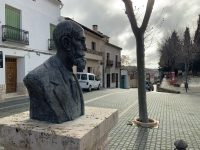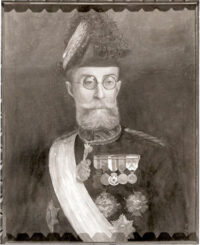This square was the commercial hub of the town, and since the streets were laid out in a radial pattern they all converge here.
Calle Angustias and Calle Sillería form the east-west axis, rising from the Puerta del Agua gate to the monastery, while Calle San Pedro and Calle El Carmen traverse the town from north to south.
Formerly known as “Plaza de la Constitución” (1845) and “Plaza Pública” (1888), the square received its present-day name of Pelayo Quintero in 1925. In 2011, after the latest renovation works, a bust of this illustrious local figure was installed to preside over the space.
Pelayo Quintero Atauri was born in Uclés on 26 June 1867 and he died in Tetouan in 1946. An archaeologist, draughtsman and the town chronicler, he studied law in Madrid while simultaneously taking classes in drawing at the schools of fine art and arts and crafts. Later on, he obtained a degree in archival, antiquarian and library studies (antecedent of the present-day history degree).
He taught drawing at arts and crafts schools in Granada, Cádiz and Seville, and in 1904 he finally settled in Cádiz, occupying a wide range of positions: delegate of the Higher Board of Excavations and Antiquities, director of excavations in Cádiz, director of the Provincial Museum of Fine Arts, fellow of the Academy of Fine Arts, member of the Monuments Committee and consul of Colombia.
Pelayo Quintero Atauri authored numerous publications, including a three-volume history of Uclés (the oldest written record of our history). In 1904, the then mayor, Doroteo de Torres, appointed him as the official town chronicler.



